What Sets the Red Tamal Apart?
The red tamal is one of the most beloved varieties of tamales in Mexican and Central American cuisine. Easily recognized by its vibrant reddish hue, this tamal derives its characteristic color from a sauce made primarily with red chiles, which are blended into the masa or used to coat the savory filling. The result is a tamal with a deep, earthy flavor and a striking appearance.
Historical Context and Cultural Importance
Red tamales can be traced back through centuries of Mesoamerican culinary tradition. The use of chile peppers as a key ingredient dates to pre-Columbian societies, where they played a fundamental role in daily cooking and ritual feasts. Over generations, the red tamal became a staple during special occasions, such as Christmas, Day of the Dead, and family celebrations, symbolizing togetherness and the passing down of food traditions.
Fundamental Ingredients and Preparation Style
At the heart of a red tamal is masa (corn dough), which is often infused or topped with a red chile sauce made from dried chiles such as guajillo, ancho, or pasilla. The filling typically consists of shredded pork, chicken, or beef stewed in the same spicy-sweet red sauce. Everything is carefully wrapped in corn husks and steamed, allowing the bold flavors to meld and the masa to become tender and aromatic.
Flavor Profile, Texture, and Appearance
Red tamales boast a robust, mildly spicy flavor tempered by the earthy sweetness of the masa. The chile sauce delivers smokiness and complexity, while the interior remains moist, slightly dense, and satisfyingly hearty. The exterior is a warm reddish-gold, and opening a freshly steamed tamal releases an inviting aroma of corn and chiles.
Common Variations
Many regions offer their own takes on the red tamal. Some swap pork for chicken, while others add vegetables like potatoes or olives. Vegetarian versions may feature beans or squash, utilizing the same chile sauce for color and spice. While the intensity of the sauce can range from mild to fiery, some cooks also add herbs or toasted spices to deepen the flavor.
Ingredient Substitutions and Adaptations
If traditional Mexican chiles are unavailable, substitutes like dried New Mexico or California chiles can provide similar notes. Masa harina from international markets works well when fresh masa isn’t accessible. For meatless options, hearty mushrooms or jackfruit can mimic the texture of shredded meats in the distinctive sauce.
Serving Ideas and Pairings
Red tamales are customarily served hot, accompanied by a side of Mexican crema, crumbly cheese, or tangy salsas to balance the richness. Popular beverage pairings include atole (a warm, spiced corn drink), Mexican hot chocolate, or a chilled glass of horchata. Whether enjoyed as a street snack or centerpiece at festive gatherings, the red tamal remains a delicious expression of culture, history, and comfort.

